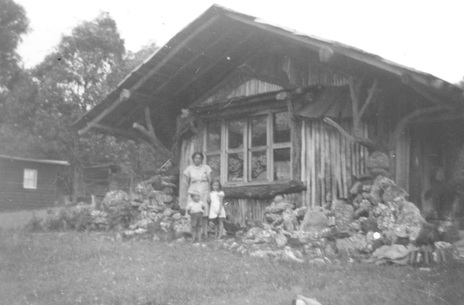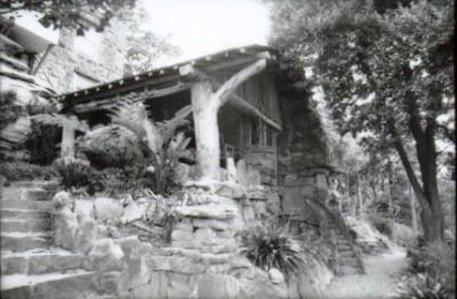Alexander JOLLEY
ALEXANDER JOLLY.
179 ANNETTS PARADE MOSSY POINT.
In the lead-up to the auction of what is now regarded as Sydney's most bizarre, albeit iconic and heritage listed home, in 2013 The Northern Star reported that:
"Alexander William Jolly was a colourful character who published two children's books [one was The Spirit of the Bush], and had a masterful vision when it came to architecture.
Responsible for five public buildings in Alstonville in his early career, including St Bartholomew's Anglican Church, Jolly was brought up in a family of carpenters with a strong connection to the local timber industry.
By all accounts he was a gentle, generous man who had a genuine love of nature and used it as a guiding light in his work.
While personal and financial challenges sabotaged a lifelong career in architecture, today he's hailed as an Australian icon, with a number of heritage-listed homes in Sydney, where he moved in 1918 at the age of 31.
Loggan Rock Cabin is a one-of-a-kind creation made of raw local timber and sandstone, and features window panes split by natural tree branches. It is routinely named as Sydney's most peculiar abode [There is the actual cabin, a tower, and a large 1950s extension].
Jolly would never return to architecture after enlisting in the army in 1941.
He pursued a career in real estate and died in 1957 at the age of 70, never realising how his buildings would one day be cherished."
Jolley wrote under the pen name of Alexander Stewart Jolley.
Having retired from office-based architecture in 1923, Jolly's ideal was to leave the "rushing hell" of the city and reconnect with the values and peace of a quiet life in nature. It's little wonder that he was lured to the then Connells Point, and was the sales agent for it. He satisfied his passion for almost fairy-tale architecture with a shack on his block at 179 Annetts Pde.
179 ANNETTS PARADE MOSSY POINT.
In the lead-up to the auction of what is now regarded as Sydney's most bizarre, albeit iconic and heritage listed home, in 2013 The Northern Star reported that:
"Alexander William Jolly was a colourful character who published two children's books [one was The Spirit of the Bush], and had a masterful vision when it came to architecture.
Responsible for five public buildings in Alstonville in his early career, including St Bartholomew's Anglican Church, Jolly was brought up in a family of carpenters with a strong connection to the local timber industry.
By all accounts he was a gentle, generous man who had a genuine love of nature and used it as a guiding light in his work.
While personal and financial challenges sabotaged a lifelong career in architecture, today he's hailed as an Australian icon, with a number of heritage-listed homes in Sydney, where he moved in 1918 at the age of 31.
Loggan Rock Cabin is a one-of-a-kind creation made of raw local timber and sandstone, and features window panes split by natural tree branches. It is routinely named as Sydney's most peculiar abode [There is the actual cabin, a tower, and a large 1950s extension].
Jolly would never return to architecture after enlisting in the army in 1941.
He pursued a career in real estate and died in 1957 at the age of 70, never realising how his buildings would one day be cherished."
Jolley wrote under the pen name of Alexander Stewart Jolley.
Having retired from office-based architecture in 1923, Jolly's ideal was to leave the "rushing hell" of the city and reconnect with the values and peace of a quiet life in nature. It's little wonder that he was lured to the then Connells Point, and was the sales agent for it. He satisfied his passion for almost fairy-tale architecture with a shack on his block at 179 Annetts Pde.
More can be found out about Loggan Rock on line.


